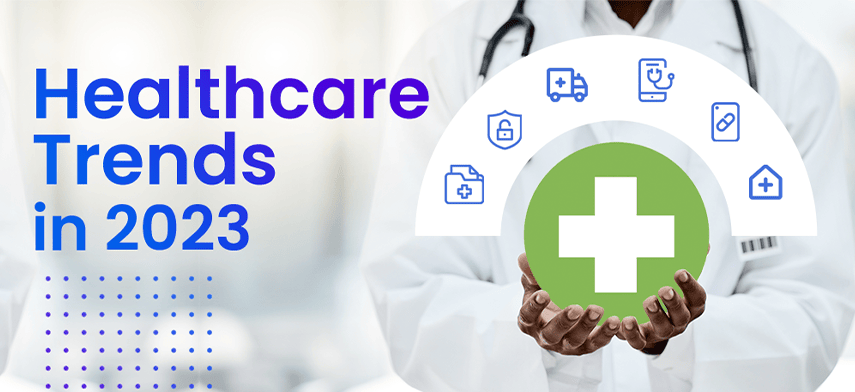2022 was the year when healthcare saw an increase in emerging technologies and many new healthcare trends for the industry. Even with the pandemic leading to a widespread economic collapse across the world. This has also accelerated digitization and innovations with tech adoption across several industries. Especially for the pharmaceutical and healthcare industry.

The usage of telehealth has increased at a significant rate and the utilization of new diagnostic and treatment tools that improved diagnostic accuracy and ultra-low freezers that are being used globally for safe vaccination storage purposes.
In 2023, experts are predicting and expecting bigger transformations with healthcare trends. Healthcare trends 2023 is set to incorporate more innovation and increase the further adoption of digital technologies and enhancements for treatment and disease prevention.
In this article we will be discussing the healthcare IT trends that will take the industry by storm in 2023.
Healthcare Trends to Watch for in 2023
The healthcare industry has changed over the past few years. Especially, in the aftermath of the pandemic with a financial recession, there was an acceleration in the general healthcare technology trends. These advancements have changed the landscape for both patients and providers. Let’s take a look at the newest health technology trends that will have an impact in 2023.
Bringing care services to improve patient care delivery
2023 will be the year of proliferation when it comes to alternative care delivery experience, whether it is at a community center, retail space, or at home. Major chains of pharmaceuticals are opening more patient care delivery sites in their retail setting. The healthcare IT trends for this particular event will help in offering primary and other care services like testing, diagnostics, screening, vaccinations, and more. The emphasis on traditional care settings will be diminished like visits to the doctor’s office or medical environment compared to providers and patients recognizing ambulatory services in care delivery services.
In common terms, care delivery as a part of healthcare trends is becoming more retail-oriented where people can simply obtain it without a lot of hassle. These trends in the healthcare industry will help to improve health equity by enhancing care accessibility amongst vulnerable populations (chronically ill, seniors, homebound, and patients living in remote settings)
Healthcare trends for direct-to-employer programs
Care access is directly impacted by the ways patients, providers, and employers view healthcare benefits. There has to be an alignment between value-based care programs and benefits designs. To insight an example, you can create a value-based care (VBC) program where the outcomes are on a reduction selection basis for patients, while you are simultaneously paying or capitating a provider entity with a fixed amount per patient visit for a prescribed program or episode. This can derail the alignment between provider payment and patient charges for specific procedures.
The current technology trends in healthcare have seen notable pressure in the financial sector that will be the outcome of accelerating direct-to-employer plans. Employers will continue to demand more financing for accountability outcomes and costs. Major brands have implemented this initiative to innovate employer-based benefit programs and plans that are not only self-funded but also provide the opportunity to promote primary care in their establishments. We will be seeing continuous attempts to harmonize the healthcare benefits where care is delivered properly.
A necessary acceleration toward patient engagement
The most crucial element of value-based care services is patient engagement and management of their health. The results are better when payers, providers, and other individuals provide patients to have access to their care charts and health information. In the movement where care delivery is taken out of the traditional hospital settings and digressed into a home and community environment, patient engagement will be one of the biggest outcomes for these healthcare trends in 2023. Patients with difficulty in getting transportation to a hospital r healthcare organization can often become disengaged and fail to meet their primary care requirements.
By initiating care delivery at home or a community center, healthcare organizations and businesses can help patients be more active in their care services. The utilization of digital healthcare services, even with the decline in the pandemic, has made patients more aware about personalized care services. They will be able to stay in touch with their providers and telehealth will become an active and permanent part of care delivery beyond 2023.
A holistic approach to influencing the healthcare market
The healthcare technology trends have been successful with one-off wellness applications and small niche audience solutions. These have been adopted by large organizations and payers to enhance benefit plans and programs allowing patients to have more choices for healthier living. Consumers adopting wearable technologies enable them to track data in support of reaching health goals. This will increasingly help healthcare organizations to formulate a holistic approach to care delivery service.
It is not just about the introduction to new technologies by how they are driving satisfying outcomes, particularly when it is related to the social determinants of health (SDOH) and patients’ lived experiences through health channels. Startups and technology organizations with maximum powerful and engaging solutions will grow in scale rapidly by taking the B2B2c path in patient care services. The biggest win is emerging technologies for in-home care diagnostics, mental health, and preventive health opportunities which will interest the big players. Applications, widgets, and wearable technologies empowering patients to track their data will be a big win and it will prompt incentives for organizational growth.
More emphasis on mental health investments
Mental health continues to be one of the crucial healthcare trends in 2023 with its significance evident during the OCVID-19 pandemic. Mental health services did face a disruption which increased the prevalence of stress, anxiety, and depression during the pandemic.
By putting more emphasis on investing in mental health solutions, technological platforms with healthcare services are making mental health services more accessible. It will continue to assist patients in connecting with mental health professionals and providers seamlessly. Through telehealth and on-demand therapy services, patients will be able to access the possibility of treatment from mobile devices with emerging technologies and platforms.

Addressing staffing shortages, employee retention rate, and clinical burnout
Employee retention, retirement, and burnout are three very significant concerns that have caused shortages in staffing in the healthcare industry. These roadblocks became more visible and apparent with the pandemic where 1 in 5 healthcare providers decided to leave due to their well-being concerns. With a shift in the aging demographics globally, individuals have longer living spans and workers will remain a requirement to help with long-term care delivery services.
Having incorporated leadership teams can retain and attract staff to reduce staff shortage and encourage flexible clinical workflows by offering the adoption of innovative digital care space, ergonomic and friendly work environment, and establishing new roles to reduce individual dependencies. Additionally, the healthcare sector is constantly evolving with technological integrations, and healthcare executives are adopting new, balanced retention and recruitment strategies. This will help in providing patients with top-tier quality care services. This is one of those healthcare trends 2023, where every individual on the radar of the healthcare industry will be searching for staffing shortage solutions.
A boost in cloud technology adoption
Cloud computing solution is becoming an increasingly and eminently involved solution for patients and providers in the healthcare industry. By utilizing and leveraging the remotely-available data, providers and patients can swiftly and easily access recent and previous clinical results in a single accumulated platform. With electronic health records (EHRs) becoming more widely available, cloud technology will be more cost-effective and safe which will create newer big data opportunities.
Cloud computing technologies will offer providers a flexible and scalable way to provide optimum patient care and concurrently enable patients to take proactive approaches to their health. Leaders in the healthcare industries should be aware of the limitation ad barriers of cloud technologies like costs of data migration, security compliance integration, interoperability standards, and cultural shifts.
Refining utilization of telehealth services
Telehealth services have been existing for years and the pandemic gave it the necessary push to increase patient-provider communication and interactions. Patients were previously hesitant with in-clinic visitations and staffing shortages in healthcare sectors. As a result, telehealth appeared as a needed solution and will remain a top healthcare trend to watch for in 2023. With limited access to healthcare providers, patients having non-emergency conditions gained access to providers more rapidly and cost-effectively than traditional clinic visits.
The brilliant concepts of remote consultations, live text and video appointments, virtual communication, and more made visits more affordable via mobile and computer devices. Telehealth systems eagles patients to directly communicate with providers and healthcare organizations regarding their concerns from insurance to prescription changes. It also enhanced patient education. Moreover, telehealth services allowed the incorporation of information from multiple patient visits, tests, diagnostics, and treatment results into the EHR systems, making it more simplified to access medical history. Telehealth services will continue to offer a seamless patient experience and will be an important differentiator for several healthcare organizations for their convenience and ease of access.
Ensuring proper data security and privacy
With cloud computing solutions and telehealth services becoming more widespread globally, data privacy and security have become a top priority and a crucial healthcare trend over the last two years. This helps providers and healthcare leaders to ensure the data of patients and personnel remain under complete protection with negligible data breaches.
Blockchain technologies are becoming widely accepted and discussed amongst healthcare players as a potential approach for healthcare data protection. Data protection and security remain an evolving landscape. With the introduction of new technologies and advancements, larger amounts of data will come with newer challenges and we need to come p with solutions to keep this data safe. To enable and strengthen patient trust, companies must incorporate and practice data privacy and security compliances to continue maximization of patient data security.
Focus on health inequalities with SDOH
Social determinants of health, commonly termed SDOH, are basic environmental conditions affecting an individual’s place of birth, livelihood, and worship. This affects a broad range of health, quality of life results, and medical risks. SDOH is a great contributor and one of the most important healthcare trends to help identify visible health disparities and inequalities impacting the health and well-being of individuals with limited access to secure and healthy choices.
Organizations like WHO and the U.S office of Disease Prevention and Health Promotion, and the CDC are launching initiatives to address SDOH challenges. with the pandemic, SDOH has become an apparent law across low- and middle-income groups and communities. With the help of data-driven programs, healthcare payers are developing the newest health technology that is more SDOH-focussed approaches to help address concerns amongst patients and providers.
Final Thoughts,
Emerging technologies like cloud computing, AI, machine learning, wearable technologies, telehealth, and robotics are just a few of the key trends that of transforming the healthcare industry. But, most major healthcare trends depend completely on making a holistic yet patient-centric approach to enhancing the quality of care delivery and its results. Furthermore, providers of mental healthcare and healthcare inequalities are areas players in the healthcare industry need to watch out for as healthcare trends 2023.
Highlighting the most important healthcare trends in 2023 will enhance your organization’s stay ahead in the competitive market and implement the necessary patient care services for the right treatment approach. The constant change in the healthcare industry may be evolving, but as patients, providers, and payers look forward to the new year, it is evident which departments will be needing more focus.

Author's Bio

Shailendra Sinhasane (Shail) is the co-founder and CEO of Mobisoft Infotech. He has been focused on cloud solutions, mobile strategy, cross-platform development, IoT innovations and advising healthcare startups in building scalable products.


